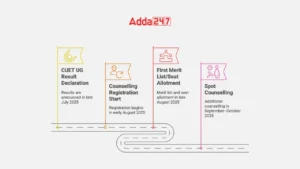The National Testing Agency has issued the CUET Chemistry Syllabus 2025 for the Common University Entrance Test for Undergraduates (CUET UG ) 2025 exam at cuet.nta.nic.in. The detailed CUET Chemistry latest syllabus is also provided below. You can also download the CUET syllabus 2025 PDF from this page. The Common University Entrance Test Chemistry Syllabus contains all the units that will be covered in the CUET Chemistry exam.
CUET Chemistry Syllabus 2025
Understanding the CUET Chemistry Syllabus 2025 is the foundation step for candidates who want to pursue higher education in the Chemistry field. CUET chemistry exam aspirants must thoroughly review the Chemistry syllabus before beginning their CUET preparation. There are three sections in the CUET Exam. Sections I covers Languages, Section II covers 23 Domain-specific Subjects, and Section III covers the General Test.
The CUET Section II comprises examinations on all domain-specific subjects. Chemistry is covered in Section II. Chemistry question papers have 50 objective questions, out of which all must be answered. Candidates will also be permitted to choose chemistry subject paper in CUET-UG that they did not study in class 12, enabling students to cross the strict disciplinary limits in higher education. The CUET UGn2025 Chemistry exam will be held on any on day from May 8 to June 1.
CUET UG Chemistry Syllabus 2025
NTA administers the Common University Entrance Test (CUET) for entry into various undergraduate programs in central/private/deemed/state universities throughout India. The CUET UG 2025 exam provide 37 subjects, including 13 languages, 23 domain subjects, and a single General Aptitude Test. Chemistry is one of the core subjects, and those intending to select Chemistry should review the CUET 2025 Chemistry Syllabus. The table below contains important information about the CUET Chemistry Exam syllabus and its exam pattern.
| CUET Chemistry Syllabus Overview | |
| Exam conducting body | National Testing Agency |
| Examination Name | Common Universities Entrance Test (CUET UG) |
| Medium of Examination | 13 Languages (English, Kannada, Hindi, Punjabi, Marathi, Tamil, Urdu, Malayalam Odia, Assamese Telugu, Bengali and Gujarati ) |
| Examination Mode | Computer-based Test (CBT) |
| Time allotted for Chemistry Exam | 60 minutes |
| Total number of questions in the Chemistry section |
50 questions |
| Total Chemistry Questions to be Answered | 50 questions |
| Total Marks in Chemistry Section | 250 Marks |
| Marking Scheme | Marks per correct answer: +5 Marks per the wrong answer: -1 Marks per unanswered questions: 0 |
CUET Chemistry Previous Year Question Paper
CUET UG Chemistry Syllabus Unit Wise
CUET Chemistry Syllabus consists of a total of 16 units. The Chemical Science Syllabus is broadly divided into 3 sections. such as physical Chemistry, Organic chemistry, and Inorganic chemistry. Those 3 sections are again broken into several topics and subtopics.
| CUET UG Chemistry Syllabus Topics | |
| Physical Chemistry | Chemical Kinetics, Surface Chemistry, Solutions, and Electrochemistry |
| Organic Chemistry | Haloalkanes and Haloarenes, Biomolecules, Aldehydes, Ketones, Carboxylic Acids, Alcohols, Phenols, Ethers, Polymers, and Chemistry in Everyday Life |
| Inorganic Chemistry | P-Block Elements, Coordination Compounds, General Principles and Processes of Isolation of Elements, and d-and f-Block Elements. |
Now, let’s discuss all the units of the CUET Chemistry Syllabus in a detailed manner below.
Unit I: Solid State
Classification of solids based on different binding forces: molecular, ionic covalent, and metallic solids, amorphous and crystalline solids(elementary idea), unit cells in two-dimensional and three-dimensional lattices, calculation of density of unit cell, packing in solids, packing efficiency, voids, number of atoms per unit cell in a cubic unit cell, point defects, electrical and magnetic properties, Band theory of metals, conductors, semiconductors and insulators and n and p-type semiconductors.
Unit II: Solutions
Types of solutions, expression of concentration of solutions of solids in liquids, the solubility of gases in liquids, solid solutions, colligative properties – the relative lowering of vapor pressure, Raoult’s law, the elevation of B.P., depression of freezing point, osmotic pressure, determination of molecular masses using colligative properties, abnormal molecular mass, VantHofffactor.
CUET Previous Year Question Paper
Unit III: Electrochemistry
Redox reactions; conductance in electrolytic solutions, specific and molar conductivity variations of conductivity with concentration, Kohlrausch’s Law, electrolysis and laws of electrolysis (elementary idea), dry cell – electrolytic cells and Galvanic cells; lead accumulator, EMF of a cell, standard electrode potential, Nernst equation and its application to chemical cells. Relation between Gibbs energy change and EMF of a cell, fuel cells; corrosion.
Unit IV: Chemical Kinetics
Rate of a reaction (average and instantaneous), factors affecting rates of reaction: concentration,
temperature, catalyst; order and molecularity of a reaction; rate law and specific rate constant, integrated rate equations, and half-life (only for zero and first-order reactions); the concept of collision theory(elementary idea, no mathematical treatment).Activation energy, Arrhenius equation.
Unit V: Surface Chemistry
Adsorption – physisorption and chemisorption; factors affecting adsorption of gases on solids; catalysis: homogenous and heterogeneous, activity and selectivity: enzyme catalysis; colloidal state: the distinction between true solutions, colloids, and suspensions; lyophilic, lyophobic multimolecular and macromolecular colloids; properties of colloids; Tyndall effect, Brownian movement, electrophoresis, coagulation; emulsions – types of emulsions.
Unit VI: General Principles and Processes of Isolation of Elements
Principles and methods of extraction – concentration, oxidation, reduction electrolytic method, and refining; occurrence and principles of extraction of aluminum, copper, zinc, and iron.
Unit VII: p-Block Elements
Group 15 elements: General introduction, electronic configuration, occurrence, oxidation states, trends in physical and chemical properties; nitrogen – preparation, properties, and uses; compounds of nitrogen: preparation and properties of ammonia and nitric acid, oxides of nitrogen ( structure only); Phosphorous-allotropic forms; compounds of phosphorous: preparation and properties of phosphine, halides (PCl3, PCl5) and oxoacids (elementary idea only).
Group 16 elements: General introduction, electronic configuration, oxidation states, occurrence, trends in physical and chemical properties; dioxygen: preparation, properties, and uses; classification of oxides; ozone. Sulfur – allotropic forms; compounds of sulphur: preparation, properties, and uses of sulphur dioxide; sulphuric acid: industrial process of manufacture, properties and uses, oxoacids of sulphur (structures only).
Group 17 elements: General introduction, electronic configuration, oxidation states, occurrence, trends in physical and chemical properties; compounds of halogens: preparation, properties and uses of chlorine and hydrochloric acid, interhalogen compounds, oxoacids of halogens(structures only).
Group 18 elements: General introduction, electronic configuration, occurrence, trends in physical and chemical properties, uses.
Unit VIII: d and f Block Elements
General introduction, electronic configuration, occurrence and characteristics of transition metals, general trends in properties of the first-row transition metals – metallic character, ionization enthalpy, oxidation states, ionic radii, colour, catalytic property, magnetic properties, interstitial compounds, alloy formation. Preparation and properties of K2Cr2O7
and KMnO4 .
Lanthanoids – electronic configuration, oxidation states, chemical reactivity, and lanthanoid contraction and its consequences.
Actinoids –Electronic configuration, oxidation states, and comparison with lanthanoids.
Unit IX Coordination Compounds
Coordination compounds: Introduction, ligands, coordination number, colour, magnetic properties and shapes, IUPAC nomenclature of mononuclear coordination compounds, bonding, Werner’s theory VBT, CFT; isomerism (structural and stereo) importance of coordination compounds (in qualitative analysis, extraction of metals and biological systems).
Unit X: Haloalkanes and Haloarenes
Haloalkanes: Nomenclature, nature ofC-Xbond, physical and chemical properties, mechanism of substitution reactions. Optical rotation.
Haloarenes: Nature of C-X bond, substitution reactions (directive influence of halogen for monosubstituted compounds only).
Uses and environmental effects of dichloromethane, trichloro methane, tetrachloro methane, iodo form, freons, DDT.
Unit XI: Alcohols, Phenols, and Ethers
Alcohols: Nomenclature, methods of preparation, physical and chemical properties (of primary alcohols only); identification of primary, secondary, and tertiary alcohols; mechanism of dehydration, uses, with special reference to methanol and ethanol.
Phenols: Nomenclature, methods of preparation, physical and chemical properties, acidic nature of phenol, electrophilic substitution reactions, uses of phenols.
Ethers: Nomenclature,methods of preparation, physical and chemical properties, uses.
Unit XII: Aldehydes, Ketones, and Carboxylic Acids
Aldehydes and Ketones: Nomenclature, nature of carbonyl group, methods of preparation, physical and chemical properties, mechanism of nucleophilic addition, the reactivity of alpha hydrogen in aldehydes; uses.
Carboxylic Acids: Nomenclature, acidic nature, methods of preparation, physical and chemical
properties; uses.
Unit XIII: Organic Compounds Containing Nitrogen
Amines: Nomenclature, classification, structure, methods of preparation, physical and chemical properties, uses, identification of primary secondary, and tertiary amines.
Cyanides and Isocyanides – will be mentioned at relevant places in context. Diazonium salts: Preparation, chemical reactions, and importance in synthetic organic chemistry.
Unit XIV: Biomolecules
Carbohydrates – Classification (aldoses and ketoses), monosaccharide (glucose and fructose), D-L configuration, oligosaccharides (sucrose, lactose, maltose), polysaccharides (starch, cellulose, glycogen): importance.
Proteins – Elementary idea of a-amino acids, peptide bond, polypeptides, proteins, primary structure, secondary structure, tertiary structure and quaternary structure (qualitative idea only), denaturation of proteins; enzymes.
Hormones –Elementary idea (excluding structure).
Vitamins – Classification and functions.
Nucleic Acids: DNA and RNA
Unit XV: Polymers
Classification – Natural and synthetic, methods of polymerization (addition and condensation),
copolymerization. Some important polymers: natural and synthetic like polythene, nylon, polyesters, bakelite, and rubber. Biodegradable and non-biodegradable polymers.
Unit XVI: Chemistry in Everyday Life
1. Chemicals in medicines – analgesics, tranquilizers, antiseptics, disinfectants, antimicrobials,
antifertility drugs, antibiotics, antacids, and antihistamines.
2. Chemicalsin food– preservatives, artificial sweetening agents, elementary idea of antioxidants.
3. Cleansing agents – soaps and detergents, cleansing action.
CUET Chemistry Syllabus 2025 PDF Download
CUET Chemistry Syllabus pdf is available on the official website of CUET i.e. cuet.nta.nic.in. Candidates can download the CUET UG Chemistry Syllabus 2025 pdf from the official site. For the benefits, here have provided the Chemistry Syllabus of CUET pdf in the below link.
CUET UG Chemistry Syllabus Covered in Books
You should study reference books in addition to regular textbooks if you want to do well on the CUET Chemistry Test. Below, our Adda247 CUET Faculty members recommend some excellent reference books for the Chemistry Syllabus of CUET.
- Chemistry Textbooks for Class 12 by NCERTs
- Modern’s ABC of Chemistry for Class 11 and 12
- A Textbook of Physical Chemistry ( Dr RK Gupta)
- A Textbook of Inorganic Chemistry by (Dr OP Tandon)
- A Textbook of Organic Chemistry by (Dr OP Tandon)
How to Prepare for CUET UG Chemistry Exam 2025?
Preparing for the CUET UG Chemistry section requires a strategic approach focusing on understanding core concepts, practicing problem-solving, and familiarizing yourself with the exam format. Here’s a step-by-step guide to help you ace CUET UG Chemistry:
Understand the Syllabus
The CUET UG Chemistry syllabus covers both Class 11 and Class 12 NCERT topics. Ensure that you’re familiar with all the topics outlined, including Physical, Organic, and Inorganic Chemistry.
Since you’re interested in the CUET 2025 syllabus, ensure that the syllabus hasn’t changed, as updates are sometimes made year to year.
Focus on Core Concepts
Chemistry requires a strong grasp of foundational concepts. Pay special attention to:
Physical Chemistry: Mole concept, thermodynamics, chemical equilibrium, and electrochemistry.
Organic Chemistry: General principles, hydrocarbons, functional groups, and basic reaction mechanisms.
Inorganic Chemistry: Periodic table trends, chemical bonding, coordination compounds, and block elements.
Use NCERT Books
NCERT Chemistry books are essential for CUET preparation as they cover the basics in a clear and concise way. Practice the questions at the end of each chapter, as they often reflect the type of questions CUET might ask.
Practice Problem-Solving
For Physical Chemistry, practice numerical problems regularly. Work on calculations involving molarity, molality, thermodynamics, and kinetics. For Organic and Inorganic Chemistry, practice reaction mechanisms, naming, and understanding periodic trends.
Solve CUET Mock Tests and Previous Papers
Mock tests will give you a feel for the timing and structure of the exam, and working with previous years’ CUET papers will show you the types of questions asked.
Analyze your performance and review topics where you tend to make mistakes.
Use Online Resources
Prepare for the exam by taking our free or premium classes at Adda247. Online flashcards or summary sheets can help in quick revisions, especially for Organic and Inorganic Chemistry.
Revise Regularly
Dedicate time for regular revision of key topics and formulas, especially those you find challenging. Create a revision schedule that allows you to revisit each topic at least a couple of times before the exam.
Time Management and Strategy
Time yourself while solving questions. Try to complete each section within a limited time to improve speed and accuracy. Develop a strategy to tackle the easy questions first, allowing more time for the tougher ones later.
Stay Updated with Exam Notifications
As CUET 2025 approaches, keep an eye on official notifications or updates regarding the syllabus or exam pattern to ensure your preparation aligns with any changes. You can follow this page for latest updates on CUET UG chemistry exam 2025.










 Allahabad University Admission Process 2...
Allahabad University Admission Process 2...
 CUET Counselling 2025: Important Dates, ...
CUET Counselling 2025: Important Dates, ...
 CUET Total Marks for 5 Subjects: Check M...
CUET Total Marks for 5 Subjects: Check M...


